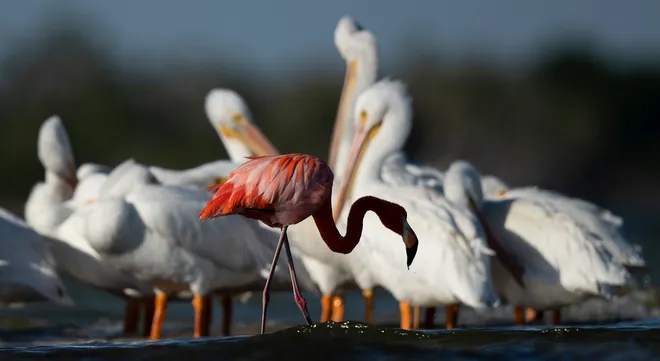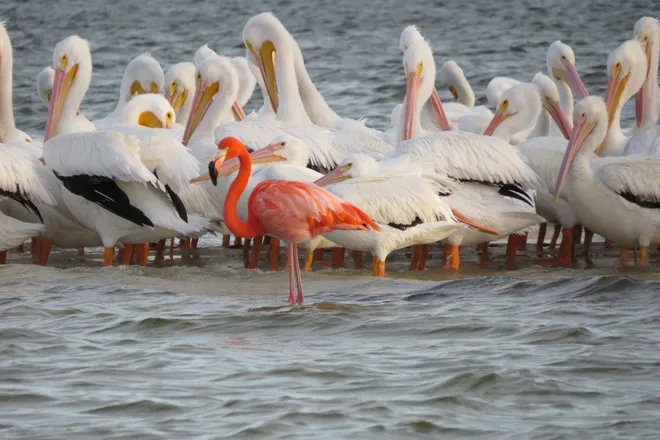Florida flamingos spotted in unusual places after Idalia: 'Where are (they) going?'
NAPLES, Fla. – From yard art to paintings, sculptures, mailboxes, T-shirts, ties, socks and underwear, the likeness of a flamingo can show up nearly anywhere in Florida.
Flamingos even adorn Florida's highly coveted lottery tickets, but there's still doubt that the bird ever lived here.
This week, flamingos showed up in the flesh as dozens of the birds were reported along the west coast of Florida – just as Hurricane Idalia chugged northward through the Gulf of Mexico. One sighting was at the Sanibel Causeway in southwest Florida.
It was the first time a flamingo had ever been documented in places like Alachua County, about 80 miles southwest of Jacksonville.
One scientist thinks the birds are from the Yucatan, that they were traveling from Mexico to Cuba, and that Idalia simply blew them off course.
"I guess the question is: where are these flamingos going, and whatever happened to Pinky," said Keith Laakkonen, director of Corkscrew Swamp Sanctuary near Naples, on Wednesday. “They’ve been seen at three different places today, the Sanibel Causeway, in Punta Gorda and Tarpon Springs.” More on Pinky later.
No one knows exactly how many of the great omnivores are in Florida right now, but some ornithologists have speculated on social media that there may be as many as 70 of the pink-and-gray birds that were blown off course.

Reports and photos of flocks of flamingos came from Bunche Beach, Blind Pass, Charlotte Harbor, Stump Pass, Punta Gorda and north all the way to Clearwater.
One this is for sure: they came here with Hurricane Idalia.
“There’s no way they’re not storm birds,” Laakonen said. “The question is: where did they come from? Was it Mexico or Cuba? There are good populations in the Yucatan, and several of the birds that were seen were juveniles. So, these birds are from a breeding population.”
Hurricane Idalia:'It's a manatee!': Watch Florida woman discover unlikely visitor in backyard after Idalia
Florida's obsession with flamingos
Although the debate about the historic prevalence of this bird in Florida still rages, people in the Sunshine State are simply crazy about anything flamingo.
The plastic yard art that Florida's known for first appeared in American culture in 1957, according to the Smithsonian.
And the tradition actually started in Leominster, Massachusetts, the proclaimed plastics capital of the world.
People dress like them for Halloween, while others watch their movements and lives online.
Social media was flooded Wednesday with images and shaky video of the birds – some of the footage was taken near the Sanibel Causeway.
Are flamingos native to Florida?
There has long been a debate among scientists about whether or not flamingos lived year-round in south Florida.
Plenty of historical anecdotal accounts have been recorded, but no one seems to know if the birds, historically, actually lived and bred here.
Jerry Lorenz is an Audubon researcher in the Florida Keys and an expert on flamingos and their history and status in Florida.
He says flamingos are native to south Florida.
"Usually, we see one here or two (in Everglades National Park of Florida Bay), but this is pretty much all over the state," Lorenz said. "There's traffic in the Yucatan in that area, and they may have been traveling from the Yucatan to Cuba. And with the storm they got pushed north as they storm grew. I really think that's what happened."
Lorenz said, historically, flamingos, at times, numbered in hundreds, perhaps even thousands, according to written account.
"To have a bird that is so iconic to the state and not have wild ones was really kind of sad," Lorenz said. "So, this is really exciting to have an iconic bird returning to its natural habitat."
Riders on the storm
This isn’t the first time flamingos or other exotic birds have been blown to Florida during a hurricane or tropical storm.
What about Pinky, the flamingo Laakonen asked about?
Pinky appears to be doing just fine, according to a report from the Tallahassee Democrat.
That very vibrant bird blew into the St. Marks National Wildlife area with Hurricane Michael in 2018 and has not yet left.
Pinky is obviously finding the food and resources it needs to survive, but no one is sure just how long bird will stay.
No one’s really sure how they’d get home, or where home even is located.
“You hope that if they are able to do well and stick around that a lot people will be able to see them in the wild because it’s pretty rare and special,” Laakonen said.
Florida had a town named Flamingo
An area known as Flamingo is still on the maps, and it functions as one of the major entrances and exits to Everglades National Park.
Today it’s used by boaters, paddlers, anglers and campers as a recreation area, but it was once a town of a few dozen shacks that were home to fishermen and farmers.
The 1910 census shows 49 people living in Flamingo and on nearby Cape Sable, with most listing their profession as fisherman.
“There were 10 heads of households, with 18 children and seven servants,” a National Park Service website about the town reads. “Five people were cane farmers and one worked in charcoal making.”

The charcoal was shipped to Key West, according to park service records.
Flamingo is also where you go to cross the Everglades by boat. You either start there and finish in Everglades City or start in Everglades City and finish in Flamingo.
There is a famous marked water trail called the Wilderness Waterway, which stretches about 100 miles across the vast park and connects Everglades City to Florida Bay.
Flamingo is also the southern-most point of the mainland United States.
Connect with this reporter: Chad Gillis on Facebook.
Hurricane:Waffle House index: 5 locations shuttered as Hurricane Idalia slams Florida
Disclaimer: The copyright of this article belongs to the original author. Reposting this article is solely for the purpose of information dissemination and does not constitute any investment advice. If there is any infringement, please contact us immediately. We will make corrections or deletions as necessary. Thank you.



